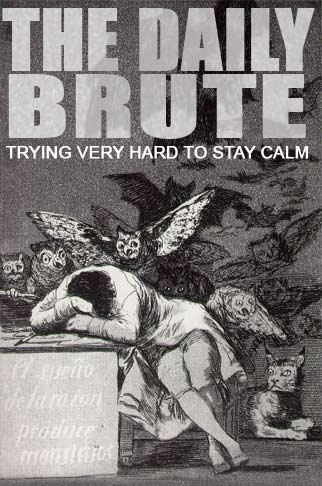
... on the Daily Brute on writing about the Bottler and his gruesome gang that will remain in place for ohh, ... at least a day. So I shall sign off on the subject merely by pointing out that, as was announced yesterday, the Bottler has unveiled plans for Fortress Britain to counter the terrorist threat and that, as An Englishman's Castle highlights, Machiavelli had something very apposite to say on rulers seeking to safeguard their subjects in just this way. Read it here.
Instead, today is officially Tintin Day on the Daily Brute.
Tintin is, incontestably, one of the great figures of the 20th century. Between 1930 and 1986, 24 Tintin titles of increasing sophistication appeared. Eight of them, published between 1949 and 1968, represent what might be called the mature Tintin, a bravura combination of technical sophistication, brilliant characterisation, supreme story telling and above all dazzling humour, the whole combining to make a mockery of the series's humble beginnings as a crude black-and-white strip cartoon published in an otherwise unmemorable right-wing Belgian children's magazine, Le Petit Vingtième.
To accord these eight masterpieces their due deference, I list them here with the dates of their publication. They are:
Prisoners of the Sun (1949)
Destination Moon (1953)
Explorers on the Moon (1954)
The Calculus Affair (1956)
The Red Sea Sharks (1958)
Tintin in Tibet (1960)
The Castafiore Emerald (1963)
Flight 714 (1968)
They were the work of Georges Remi, universally known as Hergé, the name coming from his initials reversed – RG – and the pronunciation from the fact that he was a French-speaking Belgian. If increasingly neurotic, haunted by the feeling that Tintin had taken over his life but that he could never entirely renounce him – a fact that explains the increasing gaps between publication after 1963 (the penultimate Tintin book, Tintin and the Picaros, was published in 1976, the final book, the unfinished Tintin and the Alpha-Art, in 1986, three years after Hergé's death) – anyone who could have created so utterly compelling and complete a world can only be hailed as a hero, indeed as a genius.
More particularly, there is a remarkable humanity that shines through the books (which incidentally makes a nonsense of lefty claims that Hergé was a nasty, reactionary racist and probable Nazi collaborator: any intelligent reading of the books makes clear he was anything but).
Almost any Tintin fan will probably say that their favourite character is Captain Haddock, the bearded, irascible, often buffoon-like, always accident-prone sea-dog first encountered as a sad drunk by Tintin in The Crab with the Golden Claws (1941), thereafter fiercely loyal to Tintin as well as, however improbably, the owner as a jewel-like chateau, Marlinspike Hall.
Yet it is the character of Tintin himself I find most intriguing. He began life as a boy reporter, chasing villains across the globe. He evolved into the only apparently non-caricatured figure among the principal figures in the series, always cheerful, always resolute, always level-headed. Not least as he retained his bizarre quiff to the end (and his plus-fours almost to the end), there was always a risk that he would remain a mere cypher, a bland goody-two shoes. But he isn't. He may be drawn as a kind of potato face but he is as fully realised and sympathetic as any of the more obvious caricatures in the books.
The sheer quality of Hergé's work would always have been enough to guarantee its success and, let's face it, importance. But at least for English speakers there is a further factor: the exceptional quality of the English translations, which were undertaken by Michael Turner and Leslie Lonsdale-Cooper. Heroically, they not only captured the exact flavour of the French originals but did so in a wholly unforced English idiom. It is wonderful stuff.


No comments:
Post a Comment